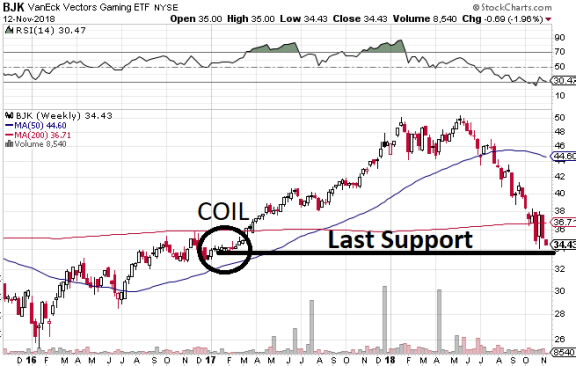After yesterday’s selloff in the S&P 500, there should be no further doubt that we are at the beginning stages of a bear market in equities. Yesterday was the third biggest one-day loss in the S&P since stocks topped on September 21st, the autumn equinox, AKA the end of the summer and the beginning of the fall, pun intended. (The equinox was technically September 23rd, but there was no trading as it was a Sunday.) The ominous sign yesterday was that the index fell back below its 200 day moving average, after attempting to regain it after last week’s really. The Nasdaq already fell through its 200DMA on Friday. The canary gaming sector fell through that level a long time ago on July 2nd, with a “death cross” on August 9th, when the 50DMA crosses below the 200DMA.
Another interesting technical sign that emphasizes the leading role of gaming equities: The 50 week moving average in the BJK gaming ETF began to fall almost exactly as the S&P 500 topped. We can be fairly confident that the fall is not over because BJK is now decisively below its 200 week moving average. After bouncing higher off its 200WMA on the week of October 15th, it broke up above it again the next week, making traders think that we were bottoming. But then it decisively broke back below the week of October 29th, and continued down the first week of November, finally closing decisively lower again this past week. You can see the war being waged between bulls and bears at the very end of this weekly chart, the 200WMA being the front lines.
The final line in the sand in gaming equities, particularly Macau stocks, is 2-year support at $33.80. This was the jump-off point for the final 50% push to May highs. Notice above (in this expertly annotated chart using state-of-the-art MS Paint technology), how at the beginning of 2017, gaming stocks coiled tightly for two months before jumping higher at the end of February last year. Break down through that coil and the next support is at about $30, about 13% lower from where we are now.
Gaming has led the S&P 500 and bottomed together with it since the financial crisis of 2008. We should not expect that to change this time around. Gaming began to seriously crash in January 2008, the broader market in September, but both bottomed together in March 2009, the upswing led by gaming. Both bottomed together in October 2011, same story. The only anomaly was the Macau collapse of 2014 which was not accompanied by a broader market decline because the Macau collapse was political in nature and not business-cycle related. Nevertheless both bottomed nearly together, about 3 weeks apart in early 2016. This is not just a coincidence. There are fundamental reasons for it. As central banks tighten credit after a prolonged liquidity punch-drunk boom, the first industries to feel the pinch are recreational, and the rot spreads from there.
